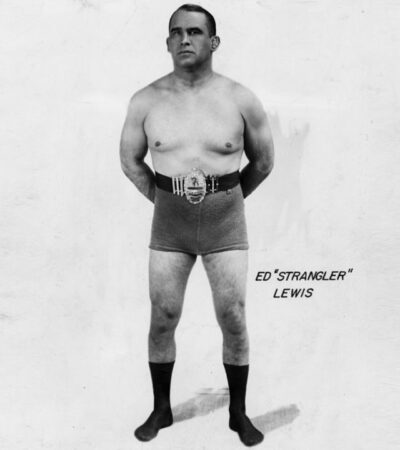Lewis försvarar sig mot Cantonwine
På torsdag, Juli 9, 1925, Ed “Strangler” Lewis made one of the early defenses of his version of the World Heavyweight Wrestling Championship in Tulsa, Oklahoma. Lewis wrestled Howard Cantonwine in front of 5,000 fans at McNulty Park.
After Stanislaus Zbyszko double-crossed Sandow’s and Lewis’ promotional group by defeating Wayne “Big” Munn legitimately, both Joe Stecher and Ed “Strangler” Lewis claimed the World Championship. It would be close to three years before Stecher and Lewis wrestled to reunify the championship.

Och “Strangler” Lewis med sitt världsbälte (Public Domain)
Born in Iowa in August 1900, Cantonwine enlisted in the U.S. Army at 16 during World War I. While in the Army, Cantonwine joined the wrestling team. The coaches found Cantonwine to be a capable wrestler and spent enough time with Cantonwine to build him into a skilled catch wrestler by the time Cantonwine left the Army.
Cantonwine returned to a manual labor job in Iowa before transitioning into professional wrestling in the early 1920s. Sandow chose Cantonwine as one of Lewis’ first opponents after Munn dropped his version of the world title back to Lewis.
Lewis and Cantonwine worked an entertaining match. Lewis made Cantonwine look strong including Lewis dropping the second fall to Cantonwine.
Lewis took the first fall in 30 minutes with a toehold. Cantonwine won the second fall in 21 minutes with a flying armlock.
During the third fall, Cantonwine picked Lewis up two or three times and tried to slam Lewis to the mat. On his last attempt to slam Lewis, Cantonwine’s feet slipped out from underneath him. Lewis landed on top of Cantonwine for the third fall and match.
The crowd, who favored Cantonwine throughout the match, booed the decision. Lewis left Cantonwine in the ring to soak up the cheers of the fans.
The Divided Championship Era has spawned commonly held beliefs about American professional wrestling from 1925 till 1928. One of the beliefs is that both Stecher and Lewis claiming the World Title confused fans and led to smaller crowds.
While the dual claims did confuse fans and give them plenty to argue about, the split title did not lead to smaller crowds at least in the beginning of both Stecher’s and Lewis’ reigns. A two-match card drawing 5,000 fans is a good drawing card in the 1920s Midwest.
You can leave a comment or ask a question about this or any post on my Facebook-sida.
Sources: The Tulsa Tribune (Tulsa, Oklahoma) Juli 10, 1925, p. 12 och 13, Den Los Angeles Times (Los Angeles, Kalifornien) Mars 26, 1977, p. 20
Nåla Det
